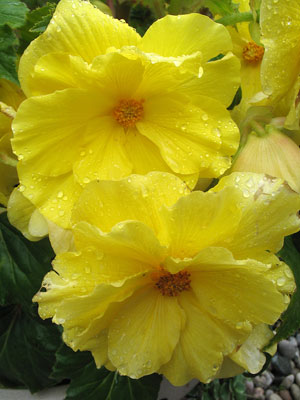There is no doubt that country decorators and gardeners certainly love large flowering plants. Our gardens are filled with roses and peonies; but have you discovered tuberous begonias?
You will certainly remember these gorgeous blooms if you have seen them — chances are, their glorious large flowers took your breath away. Tuberous begonias certainly are hard to forget. Their flowers can be huge — up to 23cm across. With truly rich colours, the silky, lustrous petals of begonias invite you to touch them to prove they’re real.
Colours range from rich velvety reds, brilliant oranges, pinks and yellows, to more subtle tones in baby pink, creamy lemon or coral. Picotee flowers have a soft colour at the base of their petals, with a broad or thin edge of red, pink or orange. When combined with ruffled petals, like a giant carnation, picotee flowered begonias are just sublime. Very few picotee flowers are as stunning as picotee begonias.
Because they are not as commonly seen as the other large flowering plants like roses of peonies, tuberous begonias sometimes create the impression of being mysterious, even unreachable. Yet with the right advice, beautiful large flowered tuberous begonias can be grown by many people in cool or temperate districts in Australia.
Growers’ secrets for the best begonias
There are three basic things you need to know to grow tuberous begonias well:
1. Select the right position. Imagine a spot where plants grow well like fuchsias, impatiens or ferns. Good light, but no burning sun, though a little morning sun won’t hurt at all. A bit of protection from wind — big leaves and big flowers can be blown over. Also, strong wind will not allow humidity to build up. Some growers have a tray of crushed rock nearby, which they wet on hot days.
2. Use the right potting mix. Large-flowered tuberous begonias are best grown in pots to show off their flamboyant blooms. Use a potting mix that is very well aerated. Experienced growers love to use perlite in their potting mix, at around 10 per cent or 1 part in 10. Perlite is available from nurseries and hydroponic suppliers. Use a slow-release fertiliser in spring when the tubers start growing; this will feed the plants over the growing season. For healthier plants and bigger flowers, water with fish emulsion or seaweed fertiliser when the plants produce buds and flowers. Don’t forget to put a stake in the pot, as these begonias have large, heavy flowers and will need tying.
3. Always water according to the needs of the plant. Tuberous begonias are succulent plants. The major mistake which people make in growing them is to water their plants too often. Because they love to be dried off a little between watering, always wait until the top of the potting mix dries before watering again. This may be every couple of days in really hot weather, or once in two weeks in cool weather. When watering a plant in active growth, apply enough water directly to the top of the potting mix so it drains from the bottom. Avoid wetting the leaves if you can.
Now comes easily the most important thing to know about growing beautiful tuberous begonias year after year. At the end of autumn, the plants begin to go dormant. Never wait for the plant to go to sleep before you stop watering it. The safest thing to do is to stop watering completely (even if the leaves are still green) at the beginning of June, or earlier if your plant shows signs of yellowing on the leaves. Keep the pot out of the rain and completely dry while the tuber is dormant over winter.
When the leaves yellow, put the plant in the garage or out of the way until it sprouts in early spring. Then you can add some slow-release fertiliser and recommence watering. Better still, in early September take the tuber out of the pot and shake off the potting mix. Re-pot it back in the same pot using fresh potting mix with slow-release fertiliser, covering the tuber by about 1cm. Keep the pot just moist, not wringing wet, for a few weeks until the tuber sprouts well, then water thoroughly, allowing the pot to dry a little between watering as described above.
Tuberous begonias can sometimes develop powdery mildew, which looks like white paint splattered on the leaves. This is easily controlled with a good fungicide like triforine. Caterpillars can be a nuisance too. Use a spray recommended for them by your nursery, such as Dipel G, which is safe for humans and other insects.
Tuberous begonias big and small
• Large flowered: tall plants to 70cm, flowers 15-23cm.
• Minis: compact plants with flowers 8-10cm.
• Basket: fully pendulous stems and flowers for baskets.
Why they look so good
• Leaves and flowers all face one way, like they are looking at you.
• Flowers open slowly and go for several weeks, giving a long-lasting display.
• Once they begin to flower, each leaf joint will produce buds.
The Aussie connection
New Australian-bred varieties are breaking new ground in colours and forms. They have big flowers with ruffled petals like giant carnations, picotee flowers, and petal edges traced with gorgeous colours which are available in Australia as dormant tubers in winter.
Begonia Festival
If you are tempted by these beautiful tuberous begonias, you may want to attend the annual begonia festival in Erica, Victoria on March 6, 7 and 8, 2010. For more information, visit www.candybell.com.au or call (03) 5165 3394.
Our thanks to renowned tuberous begonia grower Martin Farrugia for his assistance with this story. Visit his website at www.candybell.com.au for more information or to order these magnificent tubers.







